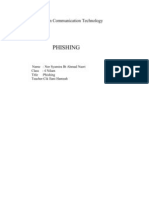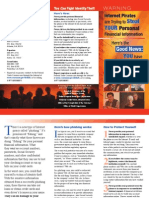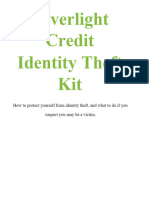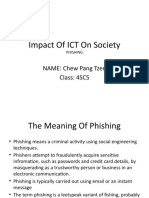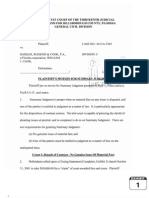Dont Get Hooked
Dont Get Hooked
Uploaded by
MKotCopyright:
Available Formats
Dont Get Hooked
Dont Get Hooked
Uploaded by
MKotCopyright
Available Formats
Share this document
Did you find this document useful?
Is this content inappropriate?
Copyright:
Available Formats
Dont Get Hooked
Dont Get Hooked
Uploaded by
MKotCopyright:
Available Formats
Don’t Get Hooked by a Phony Phisherman
Use these practices to avoid handing your personal information to a
criminal.
Scam artists often go “phishing” for private information. They’ll
send you an e-mail which appears to be from a legitimate source,
like a bank or a government agency, give you a form or a link that
looks authentic, and then ask you to provide personal information.
Before you know it, you’re a victim!
Here’s what you can do to Avoid completing and Examine the address bar in
avoid taking the bait and sending back e-mail forms if your browser. For example, if
falling prey to phishing scams. they ask for personal a link directs you to PayPal,
information. Instead, use a notice what the address bar
Be suspicious of any e-mail secure website, phone call, or displays. If you see something
asking for personal an office visit to communicate like
information. Phishing e-mails with financial institutions and http://www.scammedyou.com/
typically include upsetting or other organizations. paypal/login.htm? don’t
exciting language to get you to continue.
react without thinking, such as Double check the security
“Your password is about to of any website you use
expire—respond now.” They’ll before you supply DID YOU KNOW?
ask you for usernames, information. Phishers can According to the Anti-Phishing
WorkGroup (AWG), more than
passwords, credit card forge two indicators of a
65,000 phishing sites were
numbers, Social Security secure site: the https:// and detected in December 2015 alone.
numbers, date of birth, or the yellow lock. Instead of
other personal information. using the provided link, always
type the web address of your
Be cautious about using the financial institution directly into Log on regularly to your
links in e-mails, instant your browser. To test the online accounts. Make it a
message, or chat. If you security lock, double-click the habit to log on regularly and
suspect that the message you lock to display the security check your accounts to verify
received is not authentic or if certificate for the site. If any that all transactions are
you don’t know the sender, do type of warning displays, such legitimate.
not use the links in the e-mail. as “the address of the site
Instead, call the company or does not match the While you can’t stop phishing
type the website address certificate,” do not continue. attempts, you can refuse to
directly into your browser. take the bait. Exercise
caution, verify your sources,
and provide information only
when you know you’re putting
it into the right hands—those
of organizations like ours who
put privacy and security first.
© 2016 MediaPro Holdings, LLC
You might also like
- MARYAM Press Kit B5 - 20230113Document20 pagesMARYAM Press Kit B5 - 20230113Bobby IsmailNo ratings yet
- Phishing Awareness PowerpointDocument23 pagesPhishing Awareness PowerpointarunchockanNo ratings yet
- Final Business PlanDocument23 pagesFinal Business PlanlailaNo ratings yet
- 28 - How To Protect Yourself From CybercrimeDocument3 pages28 - How To Protect Yourself From Cybercrimemaryam.byt95No ratings yet
- Phishing, Pharming, Vishing and SmishingDocument2 pagesPhishing, Pharming, Vishing and SmishingHussain100% (1)
- Phishing Attack - Awareness and Prevention: August 17, 2012Document17 pagesPhishing Attack - Awareness and Prevention: August 17, 2012Kolade AgboolaNo ratings yet
- 6.what Is Phishing, and How Can I Avoid Falling Victim To ItDocument23 pages6.what Is Phishing, and How Can I Avoid Falling Victim To ItPrem chauhanNo ratings yet
- Social Engineering: Examples and Prevention TipsDocument4 pagesSocial Engineering: Examples and Prevention TipsFaizan AmmarNo ratings yet
- Phishing: Not The Kindof Fishingur UsedtoDocument23 pagesPhishing: Not The Kindof Fishingur UsedtoPriyankaNo ratings yet
- Threats of Phishing EmailDocument11 pagesThreats of Phishing EmailRusty CompassNo ratings yet
- Phishing: Information Communication TechnologyDocument6 pagesPhishing: Information Communication TechnologySyamira NazriNo ratings yet
- Phishing 3371Document10 pagesPhishing 3371Syafiq RiderNo ratings yet
- 1694807811156Document8 pages1694807811156nikhil020921No ratings yet
- HowtonottobescammedDocument5 pagesHowtonottobescammedHoàng LêNo ratings yet
- CIS1290 SMEPresentation Ellis LoganDocument7 pagesCIS1290 SMEPresentation Ellis LoganLogan EllisNo ratings yet
- Seminar of Internet Security LawDocument21 pagesSeminar of Internet Security Lawpintu ramNo ratings yet
- PHISHINGDocument19 pagesPHISHINGarshiahassanahmedNo ratings yet
- Cyber CrimeDocument10 pagesCyber CrimeKhyati MouryaNo ratings yet
- Pub Other Stop Id TheftDocument2 pagesPub Other Stop Id Theftapi-309082881No ratings yet
- IntroductionDocument20 pagesIntroductionaidenhamby909No ratings yet
- HowtonottobescammedDocument5 pagesHowtonottobescammedHoàng LêNo ratings yet
- Internet Fraud DocuDocument3 pagesInternet Fraud DocuCristian PalorNo ratings yet
- EC Internet Phishing ScamsDocument2 pagesEC Internet Phishing Scamsafterc82No ratings yet
- The Art of Hacking Humans: Intro To Social Engineering: PhishingDocument2 pagesThe Art of Hacking Humans: Intro To Social Engineering: PhishingdjedaiyNo ratings yet
- Red Flag FPPTXDocument19 pagesRed Flag FPPTXmsbidbedi wiadbfodnNo ratings yet
- HowtonottobescammedDocument6 pagesHowtonottobescammedHoàng LêNo ratings yet
- Data Technology Expectation of Privacy Legal PoliticalDocument2 pagesData Technology Expectation of Privacy Legal PoliticalMa. Rhodora S. Ma. NievaNo ratings yet
- Social Engineering PhishingDocument14 pagesSocial Engineering PhishingDoff ArthurNo ratings yet
- Cybersecurity Training:: Safeguarding Our Firm and Client AssetsDocument44 pagesCybersecurity Training:: Safeguarding Our Firm and Client AssetsWisnu AjiNo ratings yet
- PHISHINGDocument13 pagesPHISHINGAbhinav GoyalNo ratings yet
- How To Recognize and Avoid Phishing ScamsDocument5 pagesHow To Recognize and Avoid Phishing Scamshuriya nausheenNo ratings yet
- How To Be Secure From Social Engineering AttackDocument3 pagesHow To Be Secure From Social Engineering AttackGio RgiNo ratings yet
- Identity Theft KitDocument17 pagesIdentity Theft KitcorpNo ratings yet
- The Meaning of PhishingDocument14 pagesThe Meaning of PhishingAdrien ChewNo ratings yet
- Phishing: Ajay Muthureddy - I MBA B MeaningDocument8 pagesPhishing: Ajay Muthureddy - I MBA B MeaningPushkar Ji ShuklaNo ratings yet
- Security Awareness TrainingDocument25 pagesSecurity Awareness TrainingEneyo VictorNo ratings yet
- Presentation For CollegeDocument11 pagesPresentation For CollegeNeha SinghNo ratings yet
- Step 1: Delete It: and You're Done!Document10 pagesStep 1: Delete It: and You're Done!jas0nyecyecNo ratings yet
- Identity TheftDocument37 pagesIdentity Theftdaveshah1976No ratings yet
- What Is Phishing EmailDocument7 pagesWhat Is Phishing EmailGwenn SyNo ratings yet
- Professor Messer Sec+ Domain 1Document99 pagesProfessor Messer Sec+ Domain 1Ashley AllenNo ratings yet
- Guarding Against Online Identity Theft: A Simple Guide to Online SecurityFrom EverandGuarding Against Online Identity Theft: A Simple Guide to Online SecurityNo ratings yet
- Spam Scams and Hacking YouDocument6 pagesSpam Scams and Hacking YouMohammad JaradehNo ratings yet
- Phishing Awareness PowerpointDocument23 pagesPhishing Awareness PowerpointZiitrics SolutiionsNo ratings yet
- TemplateDocument43 pagesTemplateMary GraceNo ratings yet
- Group 5 ICT HANDOUTS-FINALDocument6 pagesGroup 5 ICT HANDOUTS-FINALLaarnie Blessful SucalNo ratings yet
- Trend Micro - Seasons WarningDocument14 pagesTrend Micro - Seasons WarningTrend ArgentinaNo ratings yet
- Information Technology As Level Chapter 4Document10 pagesInformation Technology As Level Chapter 4HeenaNo ratings yet
- Phishing AwarenessDocument20 pagesPhishing AwarenessHimawan ReinaldyNo ratings yet
- PhishingDocument16 pagesPhishingsushmita singhNo ratings yet
- PhishingDocument7 pagesPhishingaavvvNo ratings yet
- Project-Overview_20241201_211110_0000Document16 pagesProject-Overview_20241201_211110_0000orniascathleenNo ratings yet
- GR5 - Principles of Information SecurityDocument11 pagesGR5 - Principles of Information SecurityVân Anh TrầnNo ratings yet
- Phishing Scam-01Document1 pagePhishing Scam-01kpc.projects2023No ratings yet
- Security Awareness TrainingDocument25 pagesSecurity Awareness TrainingMehul dubey100% (2)
- Phishing and ID TheftDocument23 pagesPhishing and ID Theftbldeepak2319No ratings yet
- Security Awareness TrainingDocument25 pagesSecurity Awareness TrainingDaniel IdongesitNo ratings yet
- TSWSW HandbookforTacklingCyberCrimesDocument22 pagesTSWSW HandbookforTacklingCyberCrimesCall DataNo ratings yet
- Viruses and Phishing 2022Document18 pagesViruses and Phishing 2022Gwenn SyNo ratings yet
- How To Protect Yourself From Cyber-Scammers Over The Festive PeriodDocument5 pagesHow To Protect Yourself From Cyber-Scammers Over The Festive PeriodMaia FornaroNo ratings yet
- How To Be Secure From Social Engineering AttackDocument2 pagesHow To Be Secure From Social Engineering AttackGio RgiNo ratings yet
- GRC Vision, 2019 To 2024 PDFDocument11 pagesGRC Vision, 2019 To 2024 PDFMKotNo ratings yet
- FoundationalGuideTeamsGroups EbookDocument25 pagesFoundationalGuideTeamsGroups EbookMKotNo ratings yet
- Authoritative Sources - MITREDocument21 pagesAuthoritative Sources - MITREMKotNo ratings yet
- Authentication Credential RequirementsDocument19 pagesAuthentication Credential RequirementsMKotNo ratings yet
- Claroty - Support To NIST Cybersecurity FrameworkDocument14 pagesClaroty - Support To NIST Cybersecurity FrameworkMKotNo ratings yet
- Dental Council Affidavit Notification 17.03.2021 Corrected by Uma SirDocument2 pagesDental Council Affidavit Notification 17.03.2021 Corrected by Uma SirShreya Kedia100% (1)
- Registered Application JK98 125675 To SecretaryDocument3 pagesRegistered Application JK98 125675 To Secretarydograsagar.inNo ratings yet
- Annexation of Goa: India, The Then Portuguese Indian Territories ofDocument32 pagesAnnexation of Goa: India, The Then Portuguese Indian Territories ofAliNo ratings yet
- Accounting Principles Chapter 4 SolutionDocument154 pagesAccounting Principles Chapter 4 SolutionMaldin JeremiaNo ratings yet
- Menomonee Falls Express News 072515Document20 pagesMenomonee Falls Express News 072515Hometown Publications - Express NewsNo ratings yet
- DP 3759 20130119 PDFDocument40 pagesDP 3759 20130119 PDFtradingpostNo ratings yet
- Bong Bong Marcos vs. Leni Robredo PET Case No. 005 (FEB 16)Document3 pagesBong Bong Marcos vs. Leni Robredo PET Case No. 005 (FEB 16)LAIZA TRISHA M MONTALLA100% (1)
- A Barry North Celebration - Andre JutrasDocument96 pagesA Barry North Celebration - Andre JutrasEmanuela Piras100% (1)
- Drag QueensDocument14 pagesDrag Queensniza abidNo ratings yet
- Qatar v. BahrainDocument1 pageQatar v. BahrainLorielle May AranteNo ratings yet
- Presentation On Sec.32AC PDFDocument18 pagesPresentation On Sec.32AC PDFrajdeeppawarNo ratings yet
- Aadhar Card FormDocument1 pageAadhar Card FormNoobGaming 01100% (1)
- Plaintiff Motion Summary Judgment, 05-CA-7205, Gillespie V BRC (Exhibits 1-4)Document56 pagesPlaintiff Motion Summary Judgment, 05-CA-7205, Gillespie V BRC (Exhibits 1-4)Neil GillespieNo ratings yet
- User Guide-SmartKit 22.0.0 User GuideDocument65 pagesUser Guide-SmartKit 22.0.0 User Guideantex11642No ratings yet
- AP European History: Free-Response QuestionsDocument14 pagesAP European History: Free-Response QuestionsAnitaNo ratings yet
- Republic Act No. 9048Document3 pagesRepublic Act No. 9048lloyd limNo ratings yet
- How To Create Signed Based Reclassification in Group ReportingDocument9 pagesHow To Create Signed Based Reclassification in Group ReportingJose EximenoNo ratings yet
- CBSE Accountancy 12th Term 2 CH 2Document4 pagesCBSE Accountancy 12th Term 2 CH 2Nirmal GuptaNo ratings yet
- LearnerLicence NarendraDocument1 pageLearnerLicence NarendraNarendra PalNo ratings yet
- Summary of The Rotterdam RulesDocument8 pagesSummary of The Rotterdam RulesSubramanian VenkatNo ratings yet
- GeM Magazine ServiceDocument3 pagesGeM Magazine ServiceBirjesh YaduvanshiNo ratings yet
- Ardian ProposalsDocument1 pageArdian ProposalsannluvislamNo ratings yet
- Philosophy of The VEDANTA Paul DeussenDocument83 pagesPhilosophy of The VEDANTA Paul DeussenLathika MenonNo ratings yet
- Saving Union BankDocument3 pagesSaving Union BankSonu F1No ratings yet
- Tax Invoice: House No. 93B, Wagholi, Amravati Gstin/Uin: 27BRWPC9032L1Z6 State Name: Maharashtra, Code: 27Document1 pageTax Invoice: House No. 93B, Wagholi, Amravati Gstin/Uin: 27BRWPC9032L1Z6 State Name: Maharashtra, Code: 27Masy121No ratings yet
- IDBI MergerDocument5 pagesIDBI MergerprajuprathuNo ratings yet
- Exam PortionsDocument2 pagesExam PortionszubaidahzahmedNo ratings yet
- Ethico - Moral Aspect of NursingDocument37 pagesEthico - Moral Aspect of NursingMarichu Bajado100% (1)










